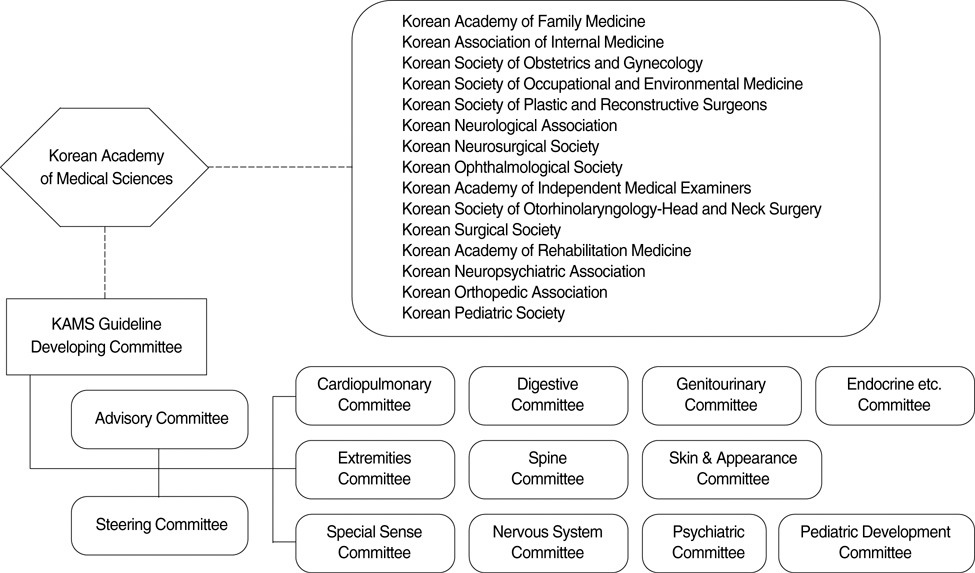J Korean Med Sci.
2009 May;24(Suppl 2):S221-S226. 10.3346/jkms.2009.24.S2.S221.
Development of the Korean Academy of Medical Sciences Guideline for Rating Physical Impairment
- Affiliations
-
- 1Department of Neurosurgery, Soonchunhyang University Chonan Hospital, Cheonan, Korea.
- 2Department of Industrial Medicine, Yonsei University, Seoul, Korea.
- 3Department of Medical Law and Ethics, Yonsei University, Seoul, Korea.
- 4Department of Preventive Medicine, Yonsei University, Seoul, Korea.
- 5Department of Sociology, Yonsei University, Seoul, Korea.
- 6Department of Legal Medicine, Seoul National University, Seoul, Korea.
- 7Department of Orthopedic Surgery, Ewha Women's University, Seoul, Korea.
- 8Department of Preventive Medicine, Seoul National University, Seoul, Korea.
- 9Graduate Program in Medical Law and Ethics, Yonsei University, Seoul, Korea.
- 10Department of Pathology, Korea University, Seoul, Korea. jongchoi0404@naver.com
- KMID: 1713805
- DOI: http://doi.org/10.3346/jkms.2009.24.S2.S221
Abstract
- Systematic and effective welfare for the disabled is possible when there are scientific and objective criteria demonstrating either presence or severity of the impairment. We need our own scientific criteria suitable for our culture and society, since the impairment is influenced by them. In 2007, we established the Developing Committee of Korean Academy of Medical Sciences (KAMS) Guideline for Impairment Rating under KAMS supervision. We included all fixed and permanent physical impairments after a sufficient medical treatment. The impairment should be stable and medically measurable. If not, it should be reevaluated later. We benchmarked the American Medical Association Guides. The KAMS Guideline should be scientific, objective, valid, reasonable and practical. In particular, we tried to secure objectivity. We developed the KAMS Guideline for Impairment Rating.
MeSH Terms
Figure
Cited by 2 articles
-
An Ideal Method of Calculating the Approved Period of Disability
Kyeong-Seok Lee, Ra-Sun Kim
Korean J Neurotrauma. 2012;8(1):10-14. doi: 10.13004/kjnt.2012.8.0.10.The Prevalence and Risk of Type 2 Diabetes in Adults with Disabilities in Korea
Inha Jung, Hyemi Kwon, Se Eun Park, Kyung-Do Han, Yong-Gyu Park, Eun-Jung Rhee, Won-Young Lee
Endocrinol Metab. 2020;35(3):552-561. doi: 10.3803/EnM.2020.653.
Reference
-
1. Lee KS, Bae HG, Yun IG, Doh JW. An estimation of economic costs for disability evaluation in Korea. Indep Med Exam. 2007. 4:28–34.2. Li Z, Kang SH, Lee SD. Review of Korean disability evaluation systems and suggestions for the improvement direction. Korean J Leg Med. 2007. 31:16–30.3. Rhee CO, Choi JK, Son MA, Moon OR. A comparative study on evaluation methods of permanent impairment in Korea. Korean J Prev Med. 1994. 27:627–651.4. Lee KS. Assessment of physical impairment and disability evaluation: problem of present system and design for better system. J Korean Neurosurg Soc. 1994. 23:276–282.5. Lee SG. Problems of assessment of physical impairment and disability evaluation in central nervous system in Korea. Indep Med Exam. 2004. 1:20–25.6. Lee SG. Review of the disability grade documents with central nervous system impairment in the law of Ministry of Health and Welfare. Indep Med Exam. 2006. 3:6–11.7. Cho KH. The present condition and problems of the guideline for disability evaluation in Korea. Indep Med Exam. 2004. 1:35–37.8. Suh T. Current status and direction of the expansion of statutory disabilities in the disability act. Indep Med Exam. 2005. 2:12–16.9. Patel B, Buschbacher R, Crawford J. National variability in permanent partial impairment ratings. Am J Phys Med Rehabil. 2003. 82:302–306.
Article10. AMA. Cocchiarella L, Andersson GBJ, editors. Philosophy, purpose, and appropriate use of the guides. Guides to the Evaluation of Permanent Impairment. 2001. 5th ed. Chicago: American Medical Association;1–16.11. McBride E. Disability evaluation and principles of treatment of compensable injuries. 1963. Philadelphia, PA: JB Lippincott Co.12. Reville RT, Seabury S, Neuhauser F. Evaluation of California's permanent disability rating schedule; Interim report. The RAND Corporation. accessed 2 Nov 2008. Available at http://www.rand.org/pubs/documented_briefings/2005/DB443.pdf .13. Lim HS, Lee KS. Results of questionnaires on the medical expert's recognition of disability in Korea. Indep Med Exam. 2007. 4:44–52.14. Jung HY. The changing concept of impairment and disability. Indep Med Exam. 2005. 2:5–11.15. Choi ES. International classification of functioning, disability and health (ICF). Indep Med Exam. 2005. 2:71–77.16. Robinson JP, Turk DC, Loeser JD. Pain, impairment, and disability in the AMA guides. J Law Med Ethics. 2004. 32:315–326.
Article17. Rondinelli RD, Katz RT. Merits and shortcomings of the American Medical Association Guides to the Evaluation of Permanent Impairment, 5th edition. A physiatric perspective. Phys Med Rehabil Clin N Am. 2002. 13:355–370.18. Lee MJ, Lee KS. A study on the laws related to disability assessment in Korea. Korean J Med Law. 2006. 14:7–19.
- Full Text Links
- Actions
-
Cited
- CITED
-
- Close
- Share
- Similar articles
-
- A Korean Academy of Medical Sciences Guides for the Evaluation of Permanent Impairment
- Guideline of the Korean Academy of Medical Sciences for Assessing Respiratory Impairment
- Development of a Rating System for Digestive System Impairments: Korean Academy of Medical Sciences Guideline
- Development of Korean Academy of Medical Sciences Guideline Rating the Physical Impairment: Lower Extremities
- Development of Korean Academy of Medical Sciences Guideline-Rating the Impairment in Pain


